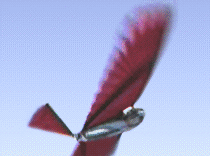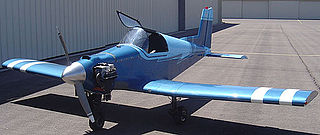
A fixed-wing aircraft is a heavier-than-air flying machine, such as an airplane, which is capable of flight using wings that generate lift caused by the aircraft's forward airspeed and the shape of the wings. Fixed-wing aircraft are distinct from rotary-wing aircraft, and ornithopters. The wings of a fixed-wing aircraft are not necessarily rigid; kites, hang gliders, variable-sweep wing aircraft and airplanes that use wing morphing are all examples of fixed-wing aircraft.

A model aircraft is a small unmanned aircraft. Many are replicas of real aircraft. Model aircraft are divided into two basic groups: flying and non-flying. Non-flying models are also termed static, display, or shelf models.

Control line is a simple and light way of controlling a flying model aircraft. The aircraft is connected to the operator by a pair of lines, attached to a handle, that work the elevator of the model. This allows the model to be controlled in the pitch axis. It is constrained to fly on the surface of a hemisphere by the control lines.

Free flight is the segment of model aviation involving aircraft with no active external control after launch. Free Flight is the original form of hobby aeromodeling, with the competitive objective being to build and launch a self controlling aircraft that will consistently achieve the longest flight duration over multiple competition rounds, within various class parameters.

An ornithopter is an aircraft that flies by flapping its wings. Designers sought to imitate the flapping-wing flight of birds, bats, and insects. Though machines may differ in form, they are usually built on the same scale as flying animals. Larger, crewed ornithopters have also been built and some have been successful. Crewed ornithopters are generally either powered by engines or by the pilot.

A paper plane is a toy aircraft, usually a glider made out of single folded sheet of paper or paperboard. A simple nose-heavy paper plane, thrown like a dart.

The Pietenpol Air Camper is a simple parasol wing homebuilt aircraft designed by Bernard H. Pietenpol. The first prototype that became the Air Camper was built and flown by Pietenpol in 1928.

A radio-controlled aircraft is a small flying machine that is radio controlled by an operator on the ground using a hand-held radio transmitter. The transmitter continuously communicates with a receiver within the craft that sends signals to servomechanisms (servos) which move the control surfaces based on the position of joysticks on the transmitter. The control surfaces, in turn, directly affect the orientation of the plane.

Corrugated plastic or corriboard – also known under the trade names of Biplex, Cartonplast, Polyflute, Coroplast, FlutePlast, IntePro, Proplex, Correx, Twinplast, Corriflute and Corflute – refers to a wide range of extruded twin-wall plastic-sheet products produced from high-impact polypropylene resin with a similar make-up to corrugated fiberboard. It is a light-weight tough material which can easily be cut with a utility knife. Manufacturers typically offer a wide variety of colors, thicknesses, and weight.

Park flyers are a class of small, primarily electric powered radio-controlled aircraft. The smallest class of park flyers are called micro planes and can be used in an enclosed area such as a gymnasium or a living room, while larger park flyers are used at park flyer sites. Models with low flying speed are more susceptible to wind and turbulence. Park flyers weigh no more than 2 pounds, allowing park flyers to have a speed limit of less than half of the current wind speed.

A radio-controlled glider is a type of radio-controlled aircraft that normally does not have any form of propulsion. They are able to sustain continuous flight by exploiting the lift produced by slopes and thermals, controlled remotely from the ground with a transmitter. They can be constructed from a variety of materials, including wood, plastic, polymer foams, and composites, and can vary in wing loading from very light to relatively heavy, depending on their intended use.

The Republic RC-3 Seabee is an all-metal amphibious sports aircraft designed by Percival Spencer and manufactured by the Republic Aircraft Corporation.

A Discus Launch Glider (DLG) is a radio controlled model sailplane launched using a 'discus launch' in which the glider is held by a wingtip and the flier rotates rapidly before release. Using this launching method, the average flier can achieve launch heights of greater than 100 feet (30 m), with contest competitors more than doubling that height and record throws approaching the 300-foot (91 m) mark.

A walkalong glider is a lightweight, slow-flying model aircraft designed to be kept aloft by controllable slope soaring in the rising air generated by the pilot who walks along with the glider as it flies, usually holding a paddle. Hands or even the forehead can also be used to create an updraft. This type of soaring differs from other types of slope soaring in that the orographic lift is following the plane as it flies in the air and thus no other wind is required.

Paul K. Guillow, Inc., commonly known as Guillow's, is an American manufacturer of balsa wood model aircraft kits.

A glider is a fixed-wing aircraft that is supported in flight by the dynamic reaction of the air against its lifting surfaces, and whose free flight does not depend on an engine. Most gliders do not have an engine, although motor-gliders have small engines for extending their flight when necessary by sustaining the altitude with some being powerful enough to take off by self-launch.

The Parker Teenie Two is a single-seat, single-engine sport aircraft first built in the United States in 1969 and marketed for homebuilding. It is a low-wing, cantilever monoplane of conventional configuration and fixed tricycle undercarriage. The cockpit was designed to be left open, but plans for a canopy to enclose it were made available, the use of which would increase the top speed of the aircraft. The Teenie Two was specifically designed to use a converted Volkswagen automobile engine for power. The outer wing panels can be detached for transport or storage.

Wings Across America 2008 (WAA-08) was a group of model airplane enthusiasts that flew a battery-powered radio-controlled aircraft (RC), designated as a park flyer, in all 48 contiguous United States with hopes to make all 50, if Alaska and Hawaii could be reached. A park flyer is a small radio-controlled plane typically flown in a field such as a local park or soccer field.

The Kline–Fogleman airfoil or KF airfoil is a simple airfoil design with single or multiple steps along the length of the wing. It was originally devised in the 1960s for paper airplanes.



















